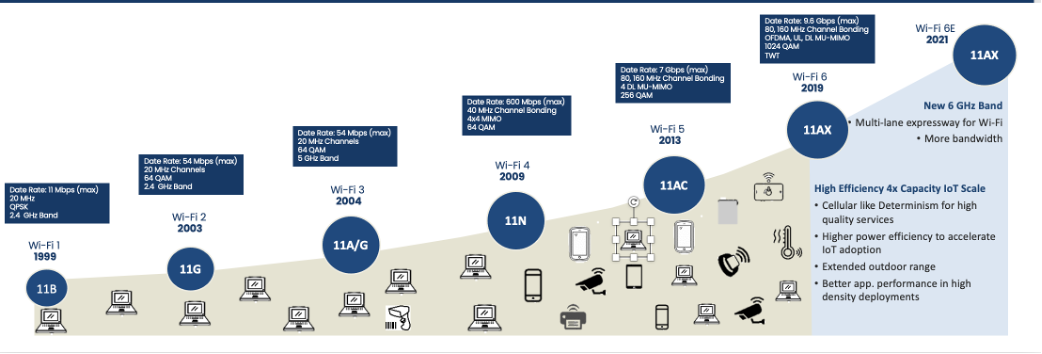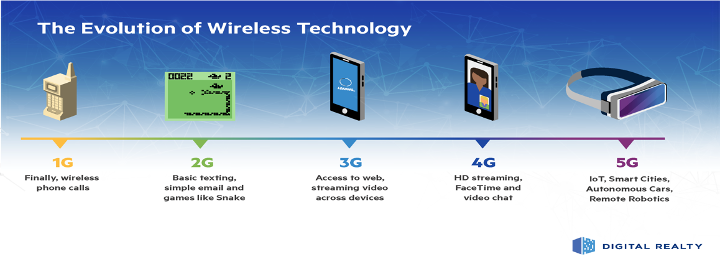7 Ways Wi-Fi6/6e can benefit your Network Environment
Wi-Fi6 is the latest Wi-Fi standard and will change the way we connect, open the gateway to more advanced and intuitive technologies, and hopefully improve the quality of our lives.

Wi-Fi6/6e was designed with common concerns in mind. If the COVID-19 lockdown taught us anything, it was the importance of staying connected. Now that we’re beyond stay-at-home orders, uninterrupted voice and video connections have become the norm and are still expected. As more IoT devices continue to come onto the network every day, more industries are embracing automation and AI than ever.
Nowadays, there's more demand for seamless connectivity and secure application use with low latency. The way technology is constantly evolving; we don’t see this demand disappearing soon.
Here are the 7 main reasons you should consider an upgrade to future proof your network environment.
1. Higher Capacity
Wi-Fi6/6e gives you a 4x increase in capacity. This means you can have more high bandwidth apps per device. Since IoT devices have assimilated into our society as a relatively normal fixture, this newer high efficiency can support IoT at scale. This is important for large-scale projects like you’d see in smart cities, hospitals, and more.
Additionally, this higher capacity and efficiency can extend your outdoor range. Which is big news for smart cities, college campuses, and any public outdoor space that could benefit from reliable Wi-Fi. Think of the possibilities!
Something else to consider is app performance. Depending on your current network infrastructure, you may or may not be utilizing apps to keep things running smoothly. Wi-Fi6 would allow for better, more seamless app performance in high-density environments. This is a big deal for hospital environments managing dozens of IoT devices on a complex network, or in a smart city where sensors are transmitting data from various locations to one dashboard.
2. Improved Security
With more devices demanding bandwidth, you need to protect them all, especially when they're safeguarded by compliance standards.
Cybersecurity has become a large issue with more apps and operations moving online. Your Wi-Fi's security MUST be able to handle sophisticated cyberthreats. Mobile medical devices on the network and IoT devices have been a target of hackers. Anomaly detection is crucial, especially when you have an abundance of such devices on your network.
Wi-Fi6/6e Security is augmented with WPA3 and RF Snapshots to achieve this. These allow you to check into your network security and quickly detect anomalies that could become real security issues. With newer technology, the requirement for stronger security is inevitable.
Learn more about the benefits of Wi-Fi6 for clinical mobility here.
3. Reduced Latency
WiFi6/6e offers faster data transfer, which results in a more reliable connection.
Wi-Fi6/6e deploys deterministic scheduling, which means you get the best of both worlds, low latency and energy efficient wireless communications according to IEEE. *
This is especially beneficial for voice and video. It improves the seamlessness of Telehealth appointments, virtual classes, and HD video calls within your environment, which enhances the overall user experience.
In a world with increasing demands for voice and video communication, you need to adapt to the demand on your network to uphold quality.
4. Power Efficiency and Extended Device Battery Life
Wi-Fi6 uses Target Wait Time to provide up to 3x better device battery life.
Traditionally, any mobile or IoT device on your network sends regular beacons to alert your network of their presence. This quickly drains the battery life of those devices. With Target Wait Time, these devices enter sleep mode until the network has information for them to process. This preserves the battery life of devices on your network, which is a tremendous benefit to hospital systems and any network supporting various devices.
5. Greater IoT Coverage
Wi-Fi6/6e offers UL/DL OFDMA (Orthogonal Frequency Division Multiple Access) in 2.4 GHz. This means that access points can simultaneously receive data from multiple clients upstream and receive the same downstream. *[2]
Each year, more devices come online that need to communicate with each other and the network.
Wi-Fi6/6e allows you to onboard billions of devices like temperature monitors, door sensors, med carts, IoT devices, sensors, etc.
Depending on your industry and the demands on your network environment, it may be time to revisit your current capabilities in this area. Can you adequately support the inevitability of an IoT invasion on your network?
6. Improved Interference Mitigation
Wi-Fi6/6e offers ~59 new non overlapping Channels vs. ~29 non overlapping on Wi-Fi5.
So why is this important?
More channels allow you to get on and off the network faster and more seamlessly. It also means less noise, as there are fewer areas of overlap on the network through more efficient channel utilization with an almost total elimination of channel reuse. A reduction in the signal-to-noise ratio creates faster data rates (sending and receiving of data). Ultimately, it creates a better quality of experience for the end user.
7. Wi-Fi6 is Complementary to 5G

You may have noticed that many cell companies are requiring their customers to upgrade to phones that are compatible with 5G (vs. 4G LTE and lower). This is just one example of how 5G technologies are becoming more common. 5G offers faster processing speeds and density. As you can see in the above image, 5G has become more prominent in the latest IoT tech, smart cities, autonomous cars, remote robotics, and more.
In short, 5G is the future of cellular. If you’re already leveraging these technologies in your environment, make sure you can accommodate an influx of more in the coming years. Wi-Fi6/6e can prepare you for mass adoption of the same clients when they roam onto your Wi-Fi6/6e WLAN from the outdoor 5G coverage.
Is it time to make the upgrade to Wi-Fi6?
As of right now, you could probably still get away with your current network setup, but mark my words, Wi-Fi6/6e will be at the forefront very soon. We’d recommend looking into it further and weighing your wireless site survey and design options. Especially if you’re not sure where to start the transition. If you’re still on the fence about making the upgrade, start consuming more information to learn about the possibilities this new Wi-Fi standard could unlock for your environment. Recently, our team helped improve the fan experience at the Nashville Superspeedway. Learn about the role WI-Fi6 played to give us that outcome.
Sources
[1] https://ieeexplore.ieee.org/document/9490255
[2] https://blogs.cisco.com/networking/wi-fi-6-ofdma-resource-unit-ru-allocations-and-mappings





